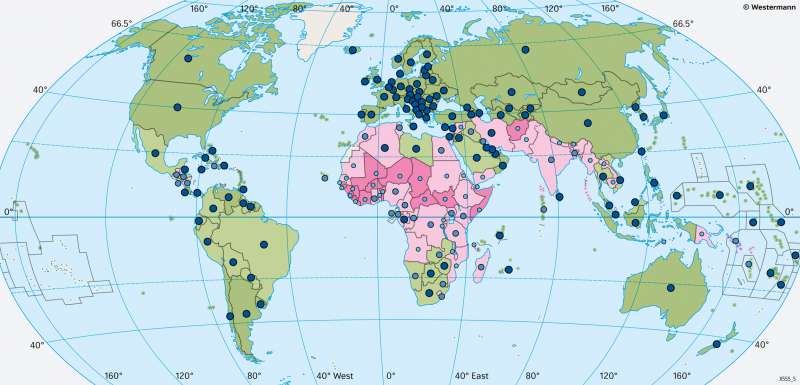The World - Education
Level of development
978-3-14-100890-6 | Page 35 | Ill. 4

Overview
Education is a high priority in development work today, as it is seen as a key to solving other problems and is often what makes active participation in economic and political life possible in the first place; be it in HIV/AIDS awareness programmes, in rural training programmes to further develop farming methods, in marketing goods produced by the people themselves or in organising a cooperative.
The map compares the countries of the world with regard to education, which allows conclusions to be drawn about participation in public and political life, the safeguarding of children's rights and equality between men and women. The two indicators of illiteracy rate (as area colour) and years of schooling (as dot signature) are shown, the latter being included as a sub-indicator in the Human Development Index (HDI) (see map 34.1).
Literacy and equality
According to a UNESCO definition, illiterate people are those who are unable to read or write a simple text about their everyday environment in a language of their own choosing. Those who can only read such a text but not write it are called semi-illiterate. Functional illiterates are people who recognise letters and are perfectly capable of writing their name and a few words, but who do not grasp the meaning of a longer text or grasp it with such difficulty that they derive practically no benefit from it. In Germany, about one in ten adults belongs to the group of functional illiterates.
Worldwide, more people are currently literate than ever before. The literacy rates began in part as early as the 1970s and has tended to continue. The rise in literacy rates began in part in the 1970s and has tended to continue, although a lack of funding for schools and literacy campaigns has slowed the increase at times. Almost two-thirds of all illiterates are women.
Spatial distribution patterns
Both indicators show a similar pattern: countries with many years of schooling often also have low illiteracy rates. In highly developed countries, where ten or more years of schooling is standard, the literacy rate is above 90 per cent. This group includes almost all countries in Europe, the USA and Canada, Japan, South Korea, Australia, and New Zealand.
The countries of Latin America (such as Argentina, Chile, or Cuba) have almost all achieved near-complete literacy or are very close to this goal. Cuba is an example of a socialist government that carried out nationwide literacy campaigns early on, in the 1960s, thus removing a major obstacle to development. Neighbouring Haiti, on the other hand, is an example of an underdeveloped country with high illiteracy rates and low years of school attendance. Other indicators (for example on nutrition and health, see map 35.5) also demonstrate Haiti's major development problems.
In Africa, literacy has advanced in the north and south of the continent, but many still have very high educational deficits. As a generalisation, it can be said that countries with a low or even very low level of development are very often also those with the greatest deficits in education, gender equality and children's rights.
In Asia, the situation is heterogeneous. While many countries have good educational data, there are still countries where illiteracy is the norm, especially in rural areas and among women and children. Often, these are countries where child labour is widespread and where there are insufficient opportunities for school attendance. This is especially true in South Asia and Afghanistan. India alone has around 260 million illiterate people, one third of all illiterate people worldwide.




